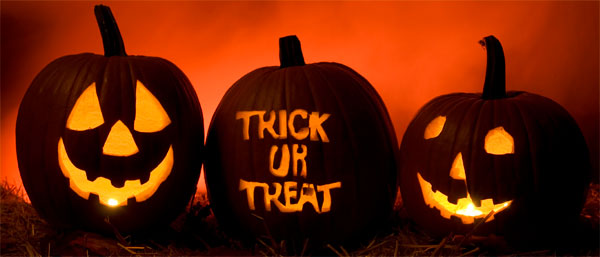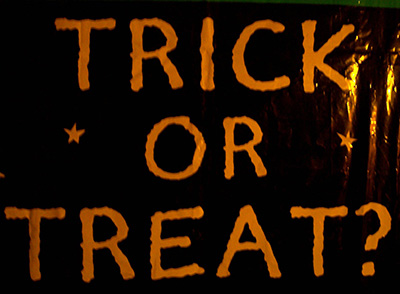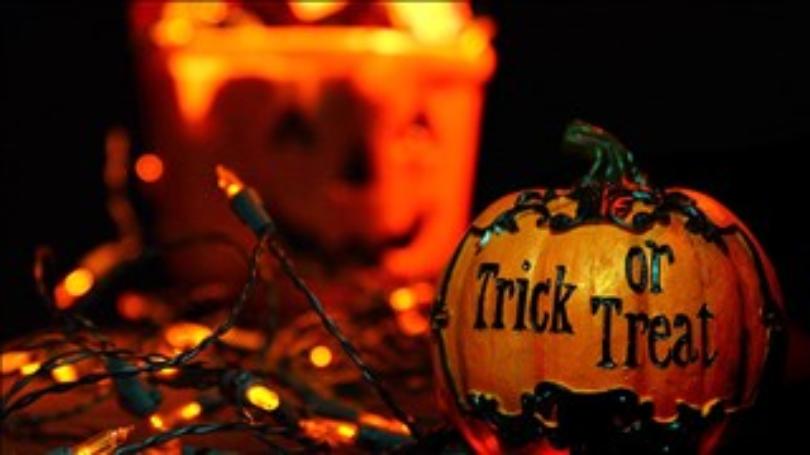
HOLY HALLOWEEN

HOLY HALLOWEEN
A Pagan Celebration … All Hallow’s Eve (Eve as in evening) ….AKA Hallowmas. Holloween is the night before the Christian holiday of “All Saints Day.” Switched from May 13 to November 1 to honor the Celtic pagan holiday of Samhain. The dressing in costumes signifies the dead walking around and getting their revenge on their enemies, the day before All Saints Day, before moving out of this world into the next life. The Halloween pumpkin and lanterns are representations of the souls in purgatory. The trick or treat custom came from Scotland and Ireland a custom called guising.
In ancient Britain, the festival known as Samhain was celebrated on October 31st. It was supposedly a day when dead souls would revisit their old homes.
According to the History Channel, Samhain was also the day when the Druids “gathered to burn crops and animals as sacrifices to the Celtic deities”.
According to Wiccans, Halloween is the time when the veil between the living and the dead is considered to be the thinnest. They believe that on this day their god “dies” and is reborn every year on the Winter Solstice. This year the winter solstice falls on December 22nd.
In ancient times, the resurrection of the sun god required human and animal sacrifice. Druids worshiped the sun god, called by names like Bel (Ba’al?) or Chrom. On October 31, they believed that he died and went into the kingdom of the dead, Anwynn. The purpose of Samhain was to insure his return. Even witches admit this involved human sacrifice.
Both animal and human blood were believed to be needed to resurrect Bel on Samhain. Human blood was believed to open the gates of Anwynn and released the spirits for a night. Thus, October 31 came to be associated with ghosts. This is not just history. Samhain is still celebrated by Pagans and is the most solemn ceremony on their “religious calendar”.
To this day, animal torture and sacrifice is still practiced on Halloween by occultists. Many animal shelters will not adopt out black cats during the month of October for this very reason.
In the early seventh century, a Catholic Pope known as Gregory the First decided that the best approach to ensure the continued spread of Catholicism was to “christianize” existing pagan holidays and practices…
As a result of their efforts to wipe out “pagan” holidays, such as Samhain, the Christians succeeded in effecting major transformations in it. In 601 A.D. Pope Gregory the First issued a now famous edict to his missionaries concerning the native beliefs and customs of the peoples he hoped to convert. Rather than try to obliterate native peoples’ customs and beliefs, the pope instructed his missionaries to use them: if a group of people worshipped a tree, rather than cut it down, he advised them to consecrate it to Christ and allow its continued worship.
The tradition of “trick-or-treating” was one of the existing pagan traditions that was later “Christianized”…
The idea of trick-or-treating is further related to the ghosts of the dead in pagan, and even Catholic, history. For example, among the ancient Druids, “The ghosts that were thought to throng about the houses of the living were greeted with a banquet-laden table. At the end of the feast, masked and costumed villagers representing the souls of the dead paraded to the outskirts of town leading the ghosts away.”
As already noted, Halloween was thought to be a night when mischievous and evil spirits roamed freely. As in modern poltergeist lore, mischievous spirits could play tricks on the living—so it was advantageous to “hide” from them by wearing costumes. Masks and costumes were worn to either scare away the ghosts or to keep from being recognized by them
The tradition of carving out a “Jack-O-Lantern” also comes from paganism. The following comes from wicca.com…
Turnips were hollowed out and carved to look like protective spirits, for this was a night of magic and chaos. The Wee Folke became very active, pulling pranks on unsuspecting humans. Traveling after dark was not advised.
Pumpkins eventually replaced turnips, but the meaning remained the same…
Here it’s a pumpkin, but in Europe it was often a turnip, or a skull with a candle in it. This serves two symbols, 1) the lord of the Dead, a “god” just like a Buddha – in short, an idol. 2) The fearsome face represented the god, Samhain, who would drive off less powerful demons that night. The lights in the Jack-o-Lantern symbolize the “faery fires” or “Will’o the Wisps” which were believed to be the lost souls flitting through the night. They also hearken back to the huge Samhain “balefires” which were lit to help conjure back the god from the darkness.
On all Satanic holy days, there are children that get ritually abused. This has been documented repeatedly, and yet most people (including most Christians) don’t want to hear about it.
For Satanists, Halloween is one of the most important celebrations of the year. On page 96 of the Satanic Bible, Anton LaVey wrote the following…
“After one’s own birthday, the two major Satanic holidays are Walpurgisnacht (May 1st) and Halloween.”
The Scriptures are very clear about this sort of thing. Deuteronomy 18:9-13 says the following: “When you enter the land the Lord your God is giving you, do not learn to imitate the detestable ways of the nations there. Let no one be found among you who sacrifices his son or daughter in the fire, who practices divination or sorcery, interprets omens, engages in witchcraft, or casts spells, or who is a medium or spiritist or who consults with the dead. Anyone who does these things is detestable to the Lord”.
In the early seventh century, a Catholic Pope known as Gregory the First decided that the best approach to ensure the continued spread of Catholicism was to “christianize” existing pagan holidays and practices…
As a result of their efforts to wipe out “pagan” holidays, such as Samhain, the Christians succeeded in effecting major transformations in it. In 601 A.D. Pope Gregory the First issued a now famous edict to his missionaries concerning the native beliefs and customs of the peoples he hoped to convert. Rather than try to obliterate native peoples’ customs and beliefs, the pope instructed his missionaries to use them: if a group of people worshipped a tree, rather than cut it down, he advised them to consecrate it to Christ and allow its continued worship.
All Saints Day, November 1, is a Holy day of Obligation that all Catholics are required to attend church services, mass, on that day.
Today Santeria is a combination of catholic practices and voodoo … same in Africa….they combine Christianity and pagan practices. Halloween is also one of their special holidays.


WICCA
For Wiccans, the festival known as “Samhain” is the time when the veil between the living and the dead is the thinnest, and so communication with the other side is the easiest. And as you will see below, it is also the time “when the god dies, to be reborn again on the Winter Solstice”. Many Americans are still very unfamiliar with Wicca, but the truth is that it is rapidly growing in popularity. In fact, it has been projected that Wicca will soon become the third largest “religion” in America after Christianity and Islam. According to the American Religious Identification Survey, the number of self-identified Wiccans in the United States grew from 8,000 in 1990 to 134,000 in 2001 to 342,000 in 2008. The New York Post recently ran an article which stated that some experts have estimated that the number of witches in the U.S. is doubling every 30 months, and that there may now be “8 million undeclared practitioners” of “the craft” in this country
October 31st is the midway point between the Autumn Equinox and the Winter Solstice. As such it is considered the end of the harvest time, when everything has stopped growing and the earth goes back to sleep. On the Wiccan calendar, known as the “wheel of the year” it is also the day when the god dies, to be reborn again on the Winter Solstice. Samhain is therefore the day when the veil between the living and the dead is considered thinnest, and is a time to remember people in our lives who have passed away.
On page 96 of the Satanic Bible, Anton LaVey wrote the following…
“After one’s own birthday, the two major Satanic holidays are Walpurgisnacht (May 1st) and Halloween.”
SPEND MONEY
Approximately 70 percent of all Americans will participate in Halloween festivities once again this year, and they will spend somewhere in the neighborhood of 6 billion dollars celebrating the holiday,
Halloween is where some people say spirits can wander the earth freely, and others say their children can wander the neighborhood unattended, trick-or-treating or causing havoc.
DRESSING UP ON HALLOWEEN COMES FROM THE CELTS.
Celts believed Samhain was a time when the wall between our world and the paranormal world was porous and spirits could get through. Because of this belief, it was common for the Celts to wear costumes and masks during the festival to ward off or befuddle any evil spirits.
THE NAME “HALLOWEEN” COMES FROM THE CATHOLICS.
Hallowmas is a three-day Catholic holiday where saints are honored and people pray for the recently deceased. At the start of the 11th century, it was decreed by the pope that it would last from Oct. 31 (All Hallow’s Eve) until Nov. 2, most likely because that was when Samhain was celebrated and the church was trying to convert the pagans.
“All Hallow’s Eve” then evolved into “All Hallow’s Even,” and by the 18th century it was commonly referred to as “Hallowe’en.”
HALLOWEEN IS STILL THE WICCAN NEW YEAR.
Halloween originates from a Celtic tradition called Samhain, a festival that marked the end of the Celtic calendar year in Ireland, Scotland, and the Isle of Man. They believed it was a time that spirits or fairies could enter our world, and the Celts would put out treats and food to placate the spirits — sometimes, a place at the table was even set for the souls of the dead.
Wiccans still celebrate Samhain as a New Year celebration today.
TURNIPS, NOT PUMPKINS.
The origin of Jack-O-Lanterns comes from a Celtic folk tale of a stingy farmer named Jack who would constantly play tricks on the devil. The devil responded by forcing him to wander purgatory with only a burning lump of coal from hell. Jack took the coal and made a lantern from a turnip, using it to guide his lost soul.
The myth was brought over by Irish families fleeing the potato famine in the 1800s, and since turnips were hard to come by in the U.S., America’s pumpkins were used as a substitute to guide lost souls and keep evil spirits like “Jack of the Lantern” away.
HALLOWEEN SYMBOLS AREN’T RANDOM.
Black cats, spiders, and bats are all Halloween symbols because of their spooky history and ties to Wiccans. All three were thought to be the familiars of witches in the middle ages, and are often associated with bad luck.
Bats are even further connected to Halloween by the ancient Samhain ritual of building a bonfire,
A FULL MOON ON HALLOWEEN IS EXTREMELY RARE.
Though a common trope in horror movies and Halloween decorations with witches flying across the full moon, the next full moon on Halloween won’t occur until 2020.
The most recent Halloween full moon was back in 2001, and before that it was in 1955.
TRICK-OR-TREATING HAS BEEN AROUND FOR A LONG TIME.
Versions of trick-or-treating have existed since medieval times. In the past, it was known as “guising” where children and poor adults went around in costumes during Hallowmas begging for food and money in exchange for songs or prayers. It was also called “souling.”
There’s a $1,000 fine for using or selling Silly String in Hollywood on Halloween.
The prank product has been banned in Hollywood since 2004 after thousands of bored people would buy it on the streets of Hollywood from illegal vendors and “vandalize” the streets. The city ordinance calls for a maximum $1,000 fine and/or six months in jail for “use, possession, sale or distribution of Silly String in Hollywood from 12:01 AM on October 31 to 12:00 PM on November 1.”
TRICK-OR-TREATING AS WE KNOW IT WAS RE-POPULARIZED BY CARTOONS.
Trick-or-treating was brought to America by the Irish and became popular during the early 20th century, but died out during WWII when sugar was rationed. After the rationing ended in 1947, children’s magazine “Jack and Jill,” radio program “The Adventures of Ozzie and Harriet,” and the “Peanuts” comic strip all helped to re-popularize the traditionof dressing up in costumes and asking for candy from door-to-door.
HALLOWEEN AND THE CANDY INDUSTRY SUPPOSEDLY INFLUENCED DAYLIGHT SAVINGS TIME.
Candy makers supposedly lobbied to extend daylight savings time into the beginning of November to get an extra hour of daylight so children could collect even more candy (thus forcing people to purchase more candy to meet the demand).
They wanted it so badly that during the 1985 hearings on Daylight Savings they put candy pumpkins on the seat of every senator, according to NPR. (The candy industry disputes this account, according to The New York Times.)
By 1952, trick-or-treating became hugely popular again.
Halloween is the second-most commercial American holiday of the year.